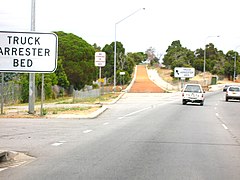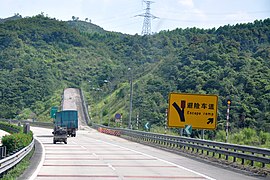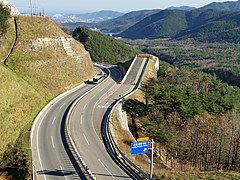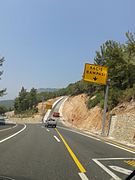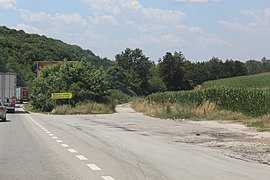
A road is a thoroughfare for the conveyance of traffic that mostly has an improved surface for use by vehicles and pedestrians. Unlike streets, whose primary function is to serve as public spaces, the main function of roads is transportation.

A road surface or pavement is the durable surface material laid down on an area intended to sustain vehicular or foot traffic, such as a road or walkway. In the past, gravel road surfaces, macadam, hoggin, cobblestone and granite setts were extensively used, but these have mostly been replaced by asphalt or concrete laid on a compacted base course. Asphalt mixtures have been used in pavement construction since the beginning of the 20th century and are of two types: metalled (hard-surfaced) and unmetalled roads. Metalled roadways are made to sustain vehicular load and so are usually made on frequently used roads. Unmetalled roads, also known as gravel roads or dirt roads, are rough and can sustain less weight. Road surfaces are frequently marked to guide traffic.

A warning sign is a type of sign which indicates a potential hazard, obstacle, or condition requiring special attention. Some are traffic signs that indicate hazards on roads that may not be readily apparent to a driver.

A shoulder, hard shoulder (British) or breakdown lane is an emergency stopping lane by the verge on the outer side of a road or motorway. Many wider freeways, or expressways elsewhere have shoulders on both sides of each directional carriageway—in the median, as well as at the outer edges of the road, for additional safety. Shoulders are not intended for use by through traffic, although there are exceptions.
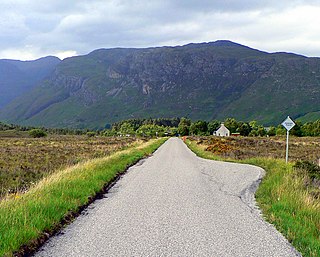
A single-track road or one-lane road is a road that permits two-way travel but is not wide enough in most places to allow vehicles to pass one another. This kind of road is common in rural areas across the United Kingdom and elsewhere. To accommodate two-way traffic, many single-track roads, especially those officially designated as such, are provided with passing places or pullouts or turnouts, or simply wide spots in the road, which may be scarcely longer than a typical car using the road. The distance between passing places varies considerably, depending on the terrain and the volume of traffic on the road. The railway equivalents of passing places are passing loops.

Rumble strips are a road safety feature to alert inattentive drivers of potential danger, by causing a tactile fuzzy vibration and audible rumbling transmitted through the wheels into the vehicle interior. A rumble strip is applied along the direction of travel following an edgeline or centerline, to alert drivers when they drift from their lane. Rumble strips may also be installed in a series across the direction of travel, to warn drivers of a stop or slowdown ahead, or of an approaching danger spot.
South Eastern Freeway is a 73 km (45 mi) freeway in South Australia (SA). It is a part of the National Highway network linking the state capital cities of Adelaide, SA, and Melbourne, Victoria, and is signed as route M1. It carries traffic over the Adelaide Hills between Adelaide and the River Murray, near Murray Bridge, where it is connected via the Swanport Bridge to the Dukes Highway, which is the main road route to Victoria.

Snow removal or snow clearing is the job of removing snow after a snowfall to make travel easier and safer. This is done both by individual households and by governments, institutions, and commercial businesses.
Standards for Interstate Highways in the United States are defined by the American Association of State Highway and Transportation Officials (AASHTO) in the publication A Policy on Design Standards: Interstate System. For a certain highway to be considered an Interstate Highway, it must meet these construction requirements or obtain a waiver from the Federal Highway Administration.

Catch points and trap points are types of points which act as railway safety devices. Both work by guiding railway carriages and trucks from a dangerous route onto a separate, safer track. Catch points are used to derail vehicles which are out of control on steep slopes. Trap points are used to protect main railway lines from unauthorised vehicles moving onto them from sidings or branch lines. Either of these track arrangements may lead the vehicles into a sand drag or safety siding, track arrangements which are used to safely stop them after they have left the main tracks.
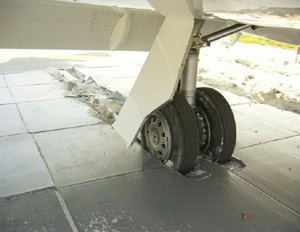
An engineered materials arrestor system, engineered materials arresting system (EMAS), or arrester bed is a bed of engineered materials built at the end of a runway to reduce the severity of the consequences of a runway excursion. Engineered materials are defined in FAA Advisory Circular No 150/5220-22B as "high energy absorbing materials of selected strength, which will reliably and predictably crush under the weight of an aircraft". While the current technology involves lightweight, crushable concrete blocks, any material that has been approved to meet the FAA Advisory Circular can be used for an EMAS. The purpose of an EMAS is to stop an aircraft overrun with no human injury and minimal aircraft damage. The aircraft is slowed by the loss of energy required to crush the EMAS material. An EMAS is similar in concept to the runaway truck ramp or race circuit gravel trap, made of gravel or sand. It is intended to stop an aircraft that has overshot a runway when there is an insufficient free space for a standard runway safety area (RSA). Multiple patents have been issued on the construction and design on the materials and process.

A gravel road is a type of unpaved road surfaced with gravel that has been brought to the site from a quarry or stream bed. Gravel roads are common in less-developed nations, and also in the rural areas of developed nations such as Canada and the United States. In New Zealand, and other Commonwealth countries, they may be known as metal roads. They may be referred to as "dirt roads" in common speech, but that term is used more for unimproved roads with no surface material added. If well constructed and maintained, a gravel road is an all-weather road.

An impact attenuator, also known as a crash cushion, crash attenuator, or cowboy cushion, is a device intended to reduce the damage to structures, vehicles, and motorists resulting from a motor vehicle collision. Impact attenuators are designed to absorb the colliding vehicle's kinetic energy. They may also be designed to redirect the vehicle away from the hazard or away from roadway machinery and workers. Impact attenuators are usually placed in front of fixed structures near highways, such as gore points, crash barrier introductions, or overpass supports. Temporary versions may be used for road construction projects.

A rut is a depression or groove worn into a road or path by the travel of wheels or skis. Ruts can be formed by wear, as from studded snow tires common in cold climate areas, or they can form through the deformation of the asphalt concrete, pavement or subbase material. In modern roads the main cause is heavily loaded trucks. These heavy loaded trucks imprint their tire impressions on roads over time, causing ruts. Rut is a common pavement distress and is often used in pavement performance modeling.
The Genting Sempah–Genting Highlands Highway is the main highway from Genting Sempah to Genting Highlands, Malaysia, a mountain resort and entertainment park. This is a private highway owned by Genting Berhad. The speed limit of the highway is 50 km/h (31 mph).
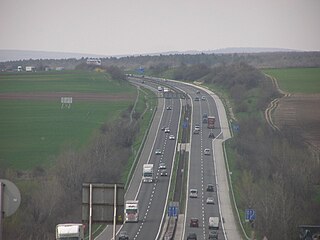
A climbing lane, crawler lane (UK), or truck lane, is an additional roadway lane that allows heavy or underpowered vehicles to ascend a steep grade without slowing other traffic. They are typically used by large trucks or semi-trailer trucks, which go uphill more slowly than they travel on level ground. They are often used on major routes such as motorways and interstate highways.

In the United States, road signs are, for the most part, standardized by federal regulations, most notably in the Manual on Uniform Traffic Control Devices (MUTCD) and its companion volume the Standard Highway Signs (SHS).
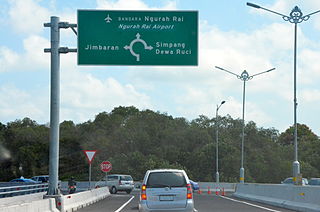
Road signs in Indonesia are standardized road signs similar to those used in other nations but with certain distinctions. As a former Dutch colony, until the 1970s road signs in Indonesia closely followed The Netherlands rules on road signs. Nowadays, Indonesian road sign design are a mix of European, US MUTCD, Australia, New Zealand and Japanese road sign features. According to the 2014 Minister of Transport's Regulation No. 13 concerning Traffic Signs, the official typeface for road signs in Indonesia is Clearview. Indonesia formerly used FHWA Series fonts as the designated typeface though the rules are not being implemented properly.

Terminology related to road transport—the transport of passengers or goods on paved routes between places—is diverse, with variation between dialects of English. There may also be regional differences within a single country, and some terms differ based on the side of the road traffic drives on. This glossary is an alphabetical listing of road transport terms.

The Transportation Research Center (TRC) is North America's largest multi-user automotive proving ground. It is operated by TRC Inc. The center occupies 4,500 acres in East Liberty, Ohio, about 40 miles northwest of Columbus, Ohio. These 4,500 acres are split between the main TRC property and a rural road/ATV course located approximately 2.5 miles from the main property.


